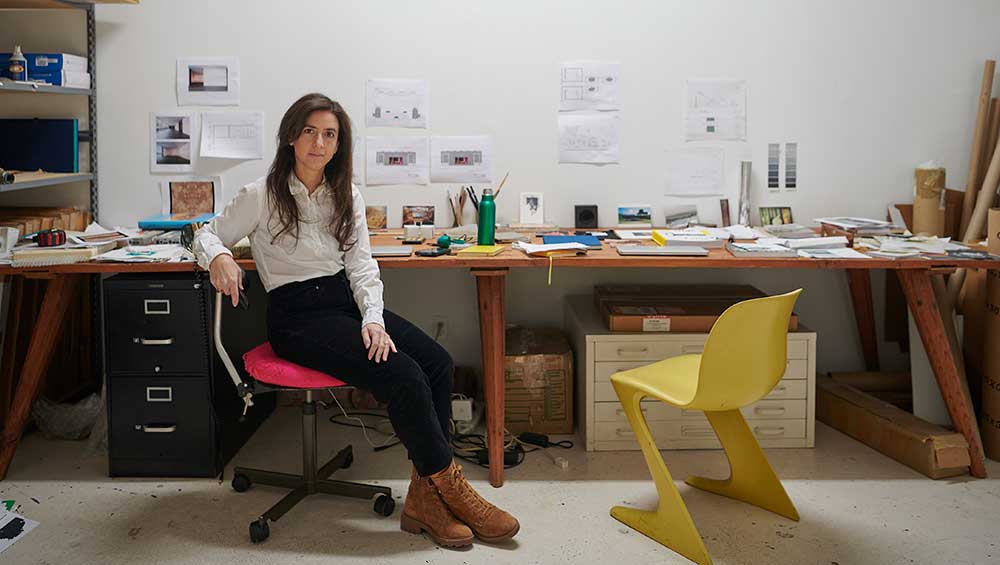
Portrait of Amie Siegel. Photo: Jason Schmidt. © Jason Schmidt. Courtesy of the artist and Thomas Dane Gallery.
by JOE LLOYD
Not far into Bloodlines (2022), an 82-minute-long work in film by the Brooklyn-based artist Amie Siegel (b1974), the camera hovers over a band of tweedy men on a shoot. It could be a scene from a period drama such as Alan Bridges’ The Shooting Party (1985), evoking a lost Britain, before the onset of the two world wars. But it is not a staged performance. It is documentary footage, of a real shoot. It was filmed only a couple of years ago. It might be a sort of re-enactment, with participants seeking to create continuity with the past, but it is not consciously laid out as such.
Bloodlines, which is presently being exhibited at London’s Thomas Dane Gallery with an associated series of prints, contains many moments in which the present seems to collapse into the past. It follows the transfer of paintings by George Stubbs, the 18th-century anatomical artist best-known for his paintings featuring horses, to a 2019 retrospective at MK Gallery, and then back again. The first, lengthiest part of the film shows the Stubbs installed in their country house homes, surrounded by the paraphernalia of aristocratic wealth.
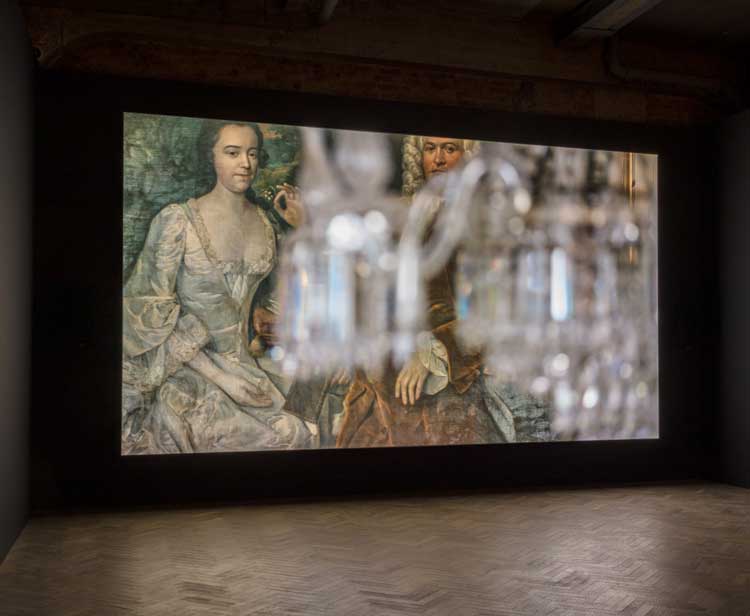
Amie Siegel: Bloodlines, installation view, Thomas Dane Gallery, London, 27 April – 23 July 2022. © Amie Siegel. Courtesy the artist and Thomas Dane Gallery.Photo: Richard Ivey.
Siegel does not consider herself a film-maker, but Bloodlines shows a meticulous understanding of the medium. There are soaring pastoral scenes shot by drone, and still closeups of the natural world that Stubbs represented. Motifs, such as heraldic symbols, wallpaper patterns and objects shaped like dogs, occur time and time again. We do not hear speech until some way in, when a pair of art handlers pack the first work off for storage. Dressed in casual black clothes, they feel like emissaries from another world, far from the palatial interiors littered with centuries of furniture. When their van drives down the drives of the great estates, the paintings within seem to be jumping from past to present.
Siegel’s works have often traced systems of value and ownership that underpin art, architecture and design through a dizzying array of topics. Previous subjects have included Casa Malaparte and Jean-Luc Godard’s Le Mépris, Le Corbusier’s Villa Savoye and an Australian imitation, the furniture trade from Chandigarh and the song My Way. Her recent work Asterisms (2021), presented at the 34th São Paulo Bienal, explored “geological and social displacement on a planetary scale” in the United Arab Emirates, with overlapping projections taking us to factories, oil rigs, show horse-training, artificial islands and much more besides.
Bloodlines is more pointed in its focus. But it explores, and provokes thought, on numerous issues: the politics of ownership, the hierarchies embedded in British society, the proper place of artworks, the relationship between public and private worlds and the connection of wealth to colonialism.
Ahead of the exhibition opening, Siegel spoke to Studio International at Thomas Dane Gallery.
Joe Lloyd: How did Bloodlines come about?
Amie Siegel: The idea came to me through a very anecdotal, offhand conversation. The last show I did with the gallery was called Backstory and, when I came to install it, I had just come from filming in the Emirates for a piece called Asterisms, which was made in 2021 and exhibited in the São Paulo Bienal. And in that work, which is a six-screen multi-channel installation, there are many different elements of that part of the world – the landscape, the geography, the social stratification that exists there. There were many things such as sand and artificial islands and movement, and displaced geologies and displaced persons and so forth. And there was also a collection of Arabian horses, the royal collection. I was looking at them as objects of value: how they’re valued, how their value is built culturally, and so forth.
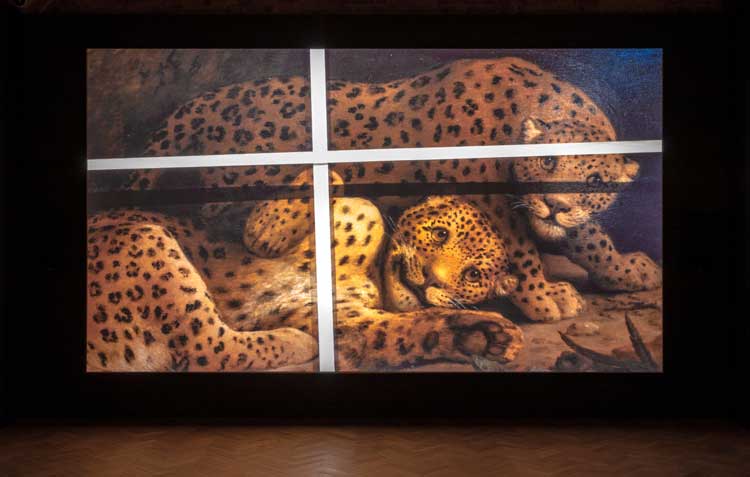
Amie Siegel: Bloodlines, installation view, Thomas Dane Gallery, London, 27 April – 23 July 2022. © Amie Siegel. Courtesy the artist and Thomas Dane Gallery.Photo: Richard Ivey.
I had just come from filming that, and I was at the exhibition opening, having a conversation with someone I know, the independent curator Paul Bonaventura. Hearing about the Arabian horses, he said: “Oh, you might be interested, I’m going to curate a Stubbs show.” And I thought: “Oh, OK, I’ll look forward to seeing that; I get it, horses.” But then he started telling me about how they were securing the loans. And through the anecdotes he told me, I started to put it together that many of the Stubbs were still held privately, in many cases in the hands of the original families who commissioned them. I thought that was fascinating.
I had the idea very suddenly, and I tried to forget about it. But it didn’t go away, it kind of came back over the next few weeks. And you know, when an idea just keeps resurfacing in your head and kind of possesses you a little bit, there’s a certain point where you have to do it, almost exorcise it.
That was the springing-off point. Then, as an artist, you think: “Oh, here I am again, in the territory of value and social stratification and so forth.” But, for me, the real turn with Asterisms was towards creatures and live creatures, and pulling them into a clinical examination of value and how that is constructed. But here you have live creatures that are represented. So, there’s a sort of double representation: the paintings, and then my representation of the paintings. And then there are also the live creatures, many of which were unanticipated. It’s not just horses, of course: there are leopards and dogs and cheetahs and panthers in the paintings, and in terms of what’s on the landscapes and people’s houses, there are dogs and deer and cows. It’s very much that era where certain figures brought things back from their commission in India. It’s so much a part of the colonial world: that exoticism vocation and the casting of a menagerie.
JL: There are so many stories of some scientist or collector acquiring a fabulous beast, only for it to die a few months later and get dissected.
AS: Of course, they always live only a year. There’s actually a Stubbs painting of a moose, that’s in the Hunterian Collection in Glasgow, and that moose apparently came over and, within a year, it perished. It’s all very interesting. But I was sort of amazed because I had made a piece a number of years ago, Provenance (2013), which follows the furniture that Pierre Jeanneret and Le Corbusier made. I always thought when it was a singular chair, it was like an orphan, and when there were many, many pieces in a home, it was like a menagerie, because it had the patina for the western owners of the so-called east. And then to do this project and come upon actual menageries, at least as they’d been represented in the Stubbs paintings, seemed like a really interesting furthering of that thought.
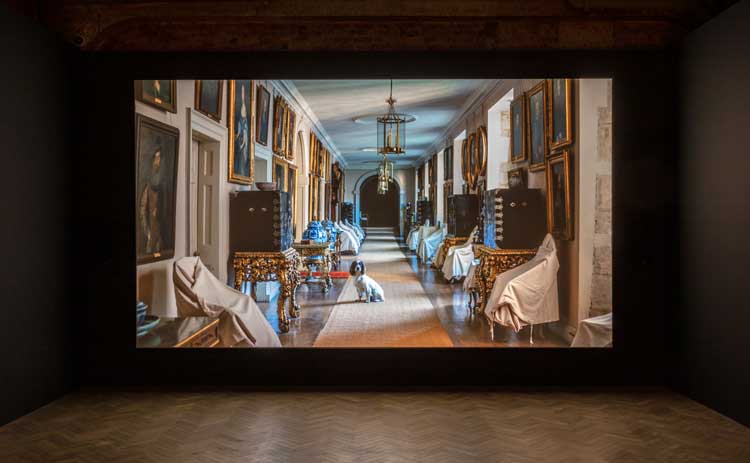
Amie Siegel: Bloodlines, installation view, Thomas Dane Gallery, London, 27 April – 23 July 2022. © Amie Siegel. Courtesy the artist and Thomas Dane Gallery.Photo: Richard Ivey.
JL: One scene early in the film has a row of chairs marked with family crests, lined up beneath a Stubbs painting.
AS: It’s interesting that you bring that up because there were certain tropes that just repeated through the vast majority of the houses. And one was the ancestral chair – I think there’s a name for it, a porter’s chair – and it sits by the entryway with the family crest on it. That fascinated me, because that and the giant ottoman, the fireplace bumper, the magazines on it appeared again and again. We came to recognise certain wallpapers.
JL: I kept seeing things that reminded me of the country houses I’ve been to – the window seat with worn upholstery, rows of wellington boots and Barbour jackets.
AS: I think those all came to be recognised as certain tropes of the English and Scottish upper classes, which are very different from those in the US. They’re still tropes, but different tropes. I think the thing that was so curious was that it’s such a self-enclosed world. The world is suspended in time.
JL: At one point in the film, there is a hunting scene, which could have occurred at any point in the last 100 years.
AS: Exactly. It’s funny to compare this to the US, but the curious thing is that would be a re-enactment, right? There’s such a difference. Because it is a sort of re-enactment here, in the sense that it is an effort at historical continuity. But in a way, when it comes into juxtaposition with the Stubbs paintings where you see these activities pictured, it’s like a re-enactment of the painting. Or it’s not even a re-enactment, but a performance that continues certain values and traditions and preoccupations, and certain ideas about the order of humans versus animals, and hierarchies and so forth.
JL: When we see contemporary activities, such as cleaners using vacuum cleaners, there is still a sense that they are playing roles that have been played for centuries.
AS: The cleaning object may have shifted, but the human being that utilises it carries on.
JL: How did you gain access to all these houses?
AS: It really depends, but I got in touch with them, or tracked them down – I’m kind of a research person, I like the idea of connecting the dots, because my hope is that everything is always accessible to everyone and anyone, and you just have to find the dots between them. I enjoy that research. Sometimes the museum was quite helpful in connecting me – they asked a few people who were loaning works but, mostly, it was me figuring it out, reading the catalogue raisonné cover to cover. I have a copy which I’ve marked up. It’s quite funny: it looks like it has a coded system to it, like little cut-up Post-its and stuff. Then I asked some folks at auction houses to point me in the right direction of how a work had been sold, or whether a family who sold a work had another Stubbs.
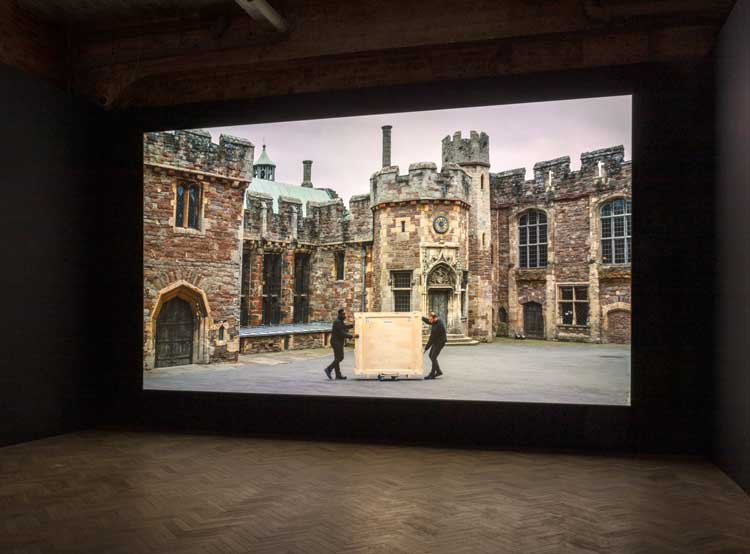
Amie Siegel: Bloodlines, installation view, Thomas Dane Gallery, London, 27 April – 23 July 2022. © Amie Siegel. Courtesy the artist and Thomas Dane Gallery.Photo: Richard Ivey.
Or, whether they gave one Stubbs to one museum but not the others. That’s often the case: one donated as inheritance tax. Many of those works, when you see them in the catalogue raisonné or their museum tombstone – the labelling – will say that it’s for tax. I find that fascinating, that these sort settlements get noted on the label, that it’s public information. It’s a good thing because it’s public money. But at the same time there’s a lot of information underneath the information, right?
Also, the question about taxes, and property, and cultural property. Those kinds of ideas about what it means to maintain a particular culture, works that culture deems a[of] value. And I’m not saying that is the case, I’m just saying that’s how the system works. And what it says about that.
JL: While many of Stubbs’s contemporaries often painted the rising bourgeoisie, he seems particularly tied to the aristocracy.
AS: They were his patrons. Through his first patrons, and also through his relationships with other painters such as Joshua Reynolds, he kind of clocked what he could do to support himself and his other interests as well. And also how connected these families were to doctors and veterinarians, things that he was seeking to access.
It’s curious because I wasn’t very interested in Stubbs before. I mean, it’s fine. And I don’t think the work is about Stubbs. But I would say that whereas he sometimes gets reduced to an equine painter, by the time I was midway through the project I had more interest in him as a social documentarian. In that way, I can kind of identify with him – almost, though not quite. Because I was interested in the animals, but I was more interested in when he represented families, or the people on horseback and so forth, or the shoots and the hunts, the activities of the British ruling class. But then, over time, I did get more interested in the animals because I started to see it all as part of the same system.
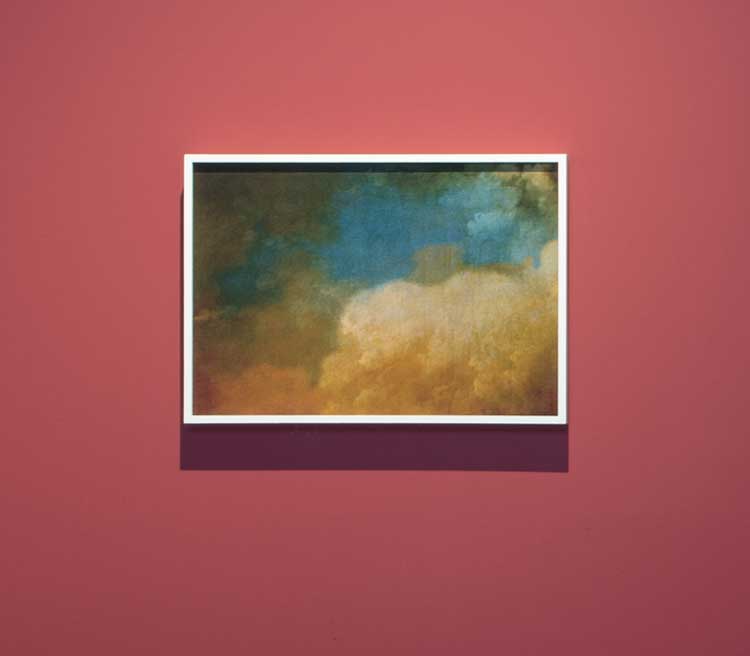
Amie Siegel: Bloodlines, installation view, Thomas Dane Gallery, London, 27 April – 23 July 2022. © Amie Siegel. Courtesy the artist and Thomas Dane Gallery.Photo: Richard Ivey.
JL: Did you talk to the paintings’ owners about the works they owned?
AS: Yeah, that was often the first conversation we had. Because it wasn’t just: “Can I come around to film your painting?” I wasn’t in the country, so it was often a phone call to talk about their relationship with the painting, because oftentimes these folks grew up with the paintings. And so [one] can really glean a lot of interesting information that way. Maybe they used to sit in a different part of the house, or maybe they always hunted there. There was good detail and psychological background there, so that’s usually where the conversation started.
JL: The three parts of the film are very different in length. The first, with the paintings in their houses, is the longest. And the second, where they are shown in the museum, is relatively brief.
AS: Yes, that’s right. I thought about that a lot. The life of paintings in an exhibition is just a blip compared to their “real lives”, on the walls of these homes. The way that the piece is timed is to make sure that the middle section is long enough to convey what it needs, but it is still relatively short compared to the other two parts.
JL: As an artist and film-maker, how did you approach filming these quite complex, object-laden homes?
AS: I don’t think I am a film-maker – I’m an artist who works with film some of the time. I also didn’t think I approached it as a film-maker. It’s curious because I think the more formal things grew out of this – the particular architectures and interiors, both the exterior architectures, all those Capability Brown landscapes and so forth, as well as the interiors of the spaces.
For the exteriors, it was often more about the relationship to the Stubbs paintings themselves and the views they afforded. Stubbs is very funny because if you start to look at the paintings in aggregation, you see a tremendous repetition in the background. I think he was a printmaker in a way, he was interested in reuse. Maybe it was a function of time, but maybe it was, I don’t know, it’s just curious to me, the same trees, the same rocky cliffs at Creswell Crags recur again and again. And not just because it’s a fantasised landscape, or not just because he didn’t have another rocky landscape. There’s something going on there.
At the time, I got very interested in working with the drone outside, because of the magisterial quality all of the shots can have, but also because the perspective they afford suggests one of great authority and all-encompassing vision. So, there’s this undercurrent questioning that, almost because they’re so over top where they gaze across the landscape and follow the deer, these incredible parklands of creatures that one would say were being preserved by the houses.
But inside, I think one of the things that this piece deploys is the vertical movement. I’m often moving horizontally, and I am very interested in that. Because if you move along something you’re always wondering what comes next. But in this case, we often went up, because the painting was hanging on the wall. You start at the fireplace and move upwards. And there’s also a closeup that’s happening at times, like along the cracked surface of the painting and then the cracks of the buildings.
JL: Watching it, I felt conflicted between seeing these paintings as things that belonged in a particular space and wanting them to be available to the public.
AS: It raises questions that I think any artist faces: should the work be maintained as it was as an anachronism or somehow moved along to the present in the sense of materiality? I think that’s a great subject. I think with a piece like this, there are many avenues to go down and explore.
JL: Another thing I noticed was that the houses are filled with real and represented animals, from pet dogs to kitsch objects shaped like hounds and foxes.
AS: There’s this passion and love for animals. And it extends to domestic animals, the roles they play in the house. They get to sit everywhere and dominate everything. But there are also the animals that get represented in things in the house. They get turned into cups and ashtrays and faces, foxes and so forth, animals for sport and play. The whole creature world is there. Which I think is something unexpected.
JL: At one point in the film, we see horses and hounds loaded into a van for a hunt. And throughout the first part, we see paintings loaded into a similar van and driven away.
AS: Right, both the hounds get loaded into the van and the paintings into the van. If you look at Asterisms, there’s also a horse-loading scene. But it doesn’t have the hounds, because that’s not part of the culture there.
JL: I suppose there is a link to those horses here, in that some of those used for hunting in 18th-century England would have been Arabian breeds.
AS: That’s pictured quite subtly in some of Stubbs’s work. There’s a painting of a shoot, and on the left you’ll see a horse that has an Arabian saddle and his tail is different. If you knew about it, you could recognise it as Arabian. And the person holding him is a black footman. There’s a compression of those two things together as exotic, which is so much of its time. And it just sits there in a painting. All these things that were perceived as external to the white British upper class get shoved into these categories of exotic where they are interchangeable. They’re of the same order where everything else is of a different order, which I thought was quite curious.
• Amie Siegel: Bloodlines is at Thomas Dane Gallery, London, until 23 July 2022, and on display at the Scottish National Gallery of Modern Art, Edinburgh until 4 September 2022.
Click on the pictures below to enlarge